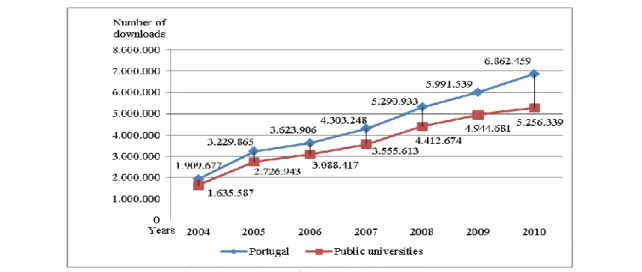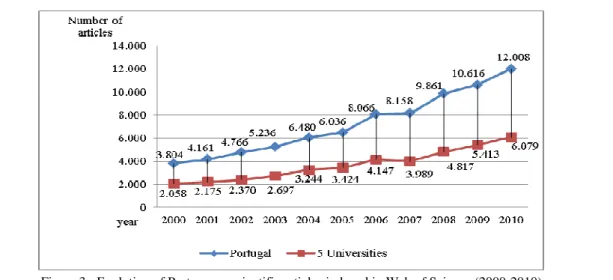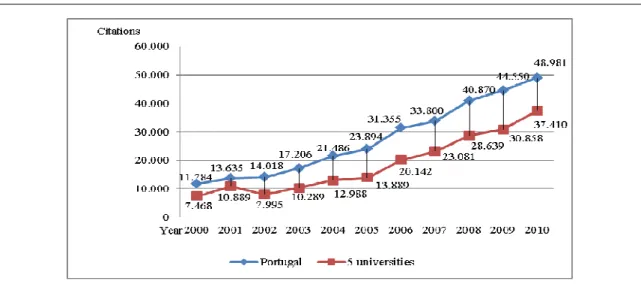The impact of the Online Knowledge Library: its use and impact on
the production of the Portuguese academic and scientific community
(2000-2010)
Teresa Costa
1, Carlos Lopes
2and Francisco Vaz
3 1CIDEHUS - Centro Interdisciplinar de História, Culturas e Sociedades da Universidade de Évora /FCCN – Fundação para Computação Científica Nacional
2
ISPA - Instituto Universitário 3
CIDEHUS - Centro Interdisciplinar de História, Culturas e Sociedades da Universidade de Évora
Abstract
In recent years several initiatives have taken place to promote universal access to the Information and Knowledge Society. It was in this context that in 2004 the Online Knowledge Library (b-on) was launched in Portugal. With it, it became easier to get access to full text international scientific publications. This study aims to present and analyse some of the statistical and bibliometric indicators of the Portuguese scientific output seeking to evaluate its link it with b-on. It was analysed the usage of b-on resources by the public universities members of the consortium from 2004 to 2010, and we chose as sample the five universities with more downloads per FTE (full time equivalent).In addition to the usage data of the consortium, we used the Web of Science (WoS) from which we identified the articles indexed by the five Portuguese universities affiliated between 2000-2010.Thus, and through a quantitative methodology, we identified the scientific production per subject area, international cooperation and scientific journals with the highest number of published articles, among others. We conclude that the availability and access to electronic resources contributes to the increased of the scientific productivity of the universities and that the study and analysis of its use and output are essential.
Keywords: Online Knowledge Library, Electronic resources, Bibliometry, Scientific Production, Portugal
1.Introduction
The development of the new information and communication technologies, especially, changes arising from the advent of the internet in the late 80s of XXth century, and the World Wide Web in the following decade, led to new forms of publishing scientific literature - moving from paper to other media, such as digital, changing the flow of communication. The Internet has become a key tool for research in universities, revolutionizing the education and the access to information worldwide. The contents of university libraries today are mainly represent by electronic resources providing access to digital information sources such as journals and databases.
With the advent of the electronic resources the cooperation between libraries was reinforced with their association in consortium to negotiate better contracts, provide access to contents in a larger scale (Big Deal), making the transition to digital information. This practice was especially developed between academic libraries, since these Institutions are the ones with greater usage of the available electronic contents.
With this study we intend to present and analyse some statistical /bibliometric indicators of the Portuguese Scientific Production seeking to associate them with the emergence of the Portuguese consortia. The emergence of the b-on consortium in 2004 has revealed very encouraging results, both in terms of the consumption of scientific content and scientific production. B-on is an undeniable success showed by the interest aroused in the scientific and academic national community revealed by the number of institutions that have decided to provide their users with access to its collection, besides, the nature of these institutions and the audience they represent. And finally, by the consistently increasing level of the statistical usage volume.
With almost ten years of existence it seems appropriate to evaluate the usefulness and availability of electronic collections provided by b-on evaluating the real needs of users through the analysis of usage statistics, as well as seeking to realize the usefulness of this quantitative and qualitative increase of the electronic information has had at the level of the Portuguese scientific output between 2000 and 2010. In spite of the fact that b-on was initially an initiative oriented towards academic community, integrates
besides universities and polytechnics, R&D institutions, public administration organizations, non-profit organizations and hospitals.
Currently b-on provides access to 17 content providers (Annual Reviews, Elsevier, Springer, Sage, Taylor & Francis, Wiley-Blackwell, Cambridge University Press, Emerald, Nature, American Chemical Society, Royal Society of Chemistry, American Institute of Physics, IEEE, Association for Computing Machinery, Society for Industrial and Applied Mathematics, Web of Knowledge, EBSCO). In 2010 b-on gave access to more than 19.000 journals, 18.000 e-books and 12.000 conference proceedings in full text, covering of the several scientific subject areas (figure 1).
In addition to scientific journals b-on provides access to thousands of e-books and to national and international open access resources among which the RCAAP project - Scientific Portuguese Repository of Open Access (www. rcaap.pt) deserves to be highlighted.
2.Objectives
As the Association of College and Research Libraries (ACRL, 2010) the analysis of resource usage is not significant if not in connection with the results, students learning and researchers production. The interest lies in measuring the impact of the library on their users.
The objectives of this study are: determine the usage that universities teachers and researchers make of the online scientific information offered by b-on; identify and characterize the scientific output of universities linking it with the increased usage of b-on’s resources; measure the level of relevance and the use of online sources; and identify the scientific subject areas with major output as well as main titles indexed in WoS with Portuguese affiliation.
3. Methods
The evaluation and improvement of the research quality carried out at universities is one of the primary goals of the European Higher Education and that contributed to bibliometrics gaining further emphasis in recent years.. The sources of information used to obtain quantitative indicators are the bibliographic databases that collect information about the articles published in scientific journals. These databases have emerged due to the huge growth of scientific publications, which led to the establishment of the management and structuring systems of information that allow to perform certain research and to retrieval relevant information. From these bibliographic resources, bibliometry founds a field of action.There are several databases with bibliometric indicators and evaluation of scientific literature, however, in this study we used WoS from Thomson Reuters, since not only is this referential database available via b-on, but also because it is the tool which is the basis for the analysis of national scientific production undertaken by the Foundation for Science and Technology and by the General Direction of Higher Education. Furthermore it is multidisciplinary and identifies all the authors of the documents, as well as their affiliation. The use of scientific databases for bibliometric studies is a lengthy and difficult process.
0 2.000 4.000 6.000 8.000 10.000 12.000 14.000 16.000 18.000 20.000 2004 2005 2006 2007 2008 2009 2010 Number of Titles Years
journals proceedings ebooks
In the particular case of WoS and due to the frequent update of its data, it was necessary to define and register the date on which it was made the final data collection (15h, November 5, 2012).
It methodological terms a survey of the number of downloads per b-on institution was made. In terms of the use of resources b-on has been growing year by year, reaching in 2010 almost 7 million of downloads, as it can be seen in Figure 2. We limited our analysis to the public universities since, and as previously mentioned these institutions are the ones with greater usage of the available b-on contents.
These figures show the importance of the electronic scientific resources for the national academic and scientific community that year by year helps to increase its use. The creation and availability of b-on was one of the most important actions in favour of that community, providing flexibility and democratizing access to scientific knowledge.Nowadays besides teaching many teachers/researchers working in universities have other tasks associated with research and investigation.
As Rodríguez-Bravo et al. (2012) says the big deal model for acquisition of electronic resources had a positive outcome which resulted in a higher consumption of scientific contents encouraged by a greater offer of the number of titles and the ease access with them. The use of scientific electronics content, despite some fluctuations, shows an ascending curve in the analysed years.
We have chosen as sample the five universities with more downloads per FTE (full time equivalent): University of Aveiro, University of Porto, University of Minho, New University of Lisbon and Technical University of Lisbon as you can see at Table1.
Table 1 – The five universities with more downloads/ FTE per year (2004-2010)
Universities 2004 2005 2006 2007 2008 2009 2010 2011
University of Aveiro 24,9 30,7 33,6 29,08 38,33 45,84 45,32 46,11 University of Porto 11,6 18,9 23,9 25,15 43,61 38,21 43,40 44,88
University of Minho 7,0 14,1 17,0 21,71 26,90 28,09 30,57 34,64
University Nova de Lisboa 8,1 14,4 15,8 17,64 22,56 28,15 29,28 29,19 University Técnica de Lisboa 9,1 15,9 16,7 20,03 22,87 24,10 20,38 20,07
After the identification of the institutions with greater usage statistics, the search strategy consisted, initially, in the recovery of all articles indexed in WoS, where the affiliation was 'Portugal' (i.e., where the author’s institutional address was Portugal) between the years 2000 and 2010 that originated from the five public universities part of the consortium. The analysis of scientific production was limited to articles since this type of document is considered as the privileged means of scientific communication.
In a second stage, a quantitative method was used to analysed several data such as output by scientific area, international collaboration (identifying countries), identification of major scientific journals, among
others, for the time period under review it was found the first indicator, that is, the authors with the largest number of articles indexed in WoS during that time period for Portugal and for each of the five institutions.
4.Results
Use of electronic resources
• Affiliation
The number of articles with Portuguese affiliation has gradually increased in recent years. We found79.192 articles indexed in WoS, with at least one Portuguese author, published in the years under analysis. Of the 79.192 articles with Portuguese affiliation, 40.413 have affiliation at least in one of the five universities considered in this study (51%).
Figure 3 - Evolution of Portuguese scientific articles indexed in Web of Science (2000-2010)
The growth rate of the number of articles with Portuguese affiliation and from the five universities was more than 300% between 2000 and 2010.The affiliation of the authors indicates that from the five institutions analysed it is the University of Porto the one with more articles indexed in WoS and with higher number of citations. It should be noted that regarding the institutions with higher output, the number of articles equals the sum of all authors from the same institution which very often are co-authors in their research.
• Citations
The citations count is one of the more important measures of the scientific literature impact. However, its use has been controversial and criticized in recent years.
Despite all the critiques, the citation count continued to be an important bibliometric indicator which in our case we rely on the number of articles indexed in WoS from 2000 to 2010, we have decided to extend the analysis of citations to 2012. This option allowed us to analyse under the same conditions all articles citations received in the publication year and the following two years.
In Figure 4 we can see the same ascending trend already checked at the published articles and note that the increase of the number of citations is exponential. The growth rate of the number of citations to Portuguese articles was of 415%, and the in the case of the five universities was of 500%.
Figure 4- Evolution of citations to scientific articles indexed in Web of Science (2000-2010)
• Research areas
From the total of the 79.192 articles identified with "Portugal" affiliation we identified the five research areas with the largest number of articles. The national scientific production concerning the scientific areas is relatively diverse. The same analysis was made for the total of articles indexed with a minimum of one author with affiliation in one of five universities, and we found exactly the same trends. Chemistry, Physics and Engineering are the subject areas with more indexed articles, representing 35% of total of Portuguese articles in WoS between 2000 and 2010.
Figure 5 - Top 5 research areas (2000-2010)
• International collaboration
The same article can have multiple authors, with different institutional affiliations from different nationalities. Figure 6 illustrates Portugal´s international collaboration in research, and we can verify that the Portuguese international co-authorship with the USA (6.791) and Spain (6.720) is very similar. We can try to explain the situation concerning the USA by the fact that Portuguese authors know that the Americans authors are highly recognized and cited. Regarding Spain the geographical proximity contributes to the collaboration between the two countries
Figure 6 – International collaboration in research (2000-2010)
• Publications
It is not surprising that English is the most used language to disseminate the national research outputs, that is published in international journals either by the five institutions or at global national level.
Table 2-WoS indexed publications with more Portuguese articles (2000-2010)1
Title PT 5 Univ
Lecture Notes in Computer Science 740 428
Materials Science Forum 497 312
Physical Review D 496 357
Allergy 424 8
European Heart Journal 414 -
Physics Letters B 251 170
Journal of Physical Chemistry B 302 161
In our case it’s interesting that the first three titles are the same in both cases.
5.Conclusions
This work analysis the use of the Portuguese b-on consortium resources by its institutional members. As anticipated we confirmed that the type of institution with more downloads are the universities. These institutions are also the ones with more articles indexed in the WoS database (the platform chosen to analyse the data).
We believe that the availability of electronic resources contributes to the higher productivity of universities. Regarding this Tenopir & King (2008) say that there are differences between academics with high consumption of information and the remaining ones concerning the scientific output. The best known researchers made an intensive use of journals. In fact, as noted by CIBER (2011), intensive use of e-journals is a reliable indicator of future research success and has resulted in changes in the scientific communication model.
The general trend is therefore to an increase of publications of Portuguese authors / researchers in
1
In bold are the five titles with more articles from Portugal and from the universities in the study and that match in the top 3
scientific journals, although the percentage in the social sciences remains much lower than that of science and technology. These are the ones with greatest number of articles with Portuguese affiliation and international collaboration. Citations to Portuguese authors increased exponentially.
B-on is currently an undeniable case of success. It indicates that the interest produced in the national scientific and academic community demonstrated in the number of institutions that have decided to provide their users access to the collection of publications available on it. It indicates, finally, the volume of use of b-on resources with a consistently increase of usage statistics.
References
ACRL, Association of College and Research Libraries. (2010). Value of academic libraries: a comprehensive research review and report. Researched by Megan Oakleaf. Chicago. http://www.acrl.ala.org/value CIBER, Centre for Information Behaviour and the Evaluation of Research.. (2011). E-Journals: Their Use, Value
and Impact: Final Report: Research Information Network. London:City University.
http://www.rin.ac.uk/our-work/communicating-and-disseminating-research/e-journals-their-use-value-and-impact
Rodríguez-Bravo, B., Alvite-Diez, M.-L., Morán-Suárez, M.-A., & Marraud, G. (2012). Impacto de la contratación de colecciones de revistas electrónicas en la productividad de la Universidad de Vigo. El profesional de
la información, 21(6), 585-594. doi:10.3145/epi.2012.nov.05
Tenopir, C., & King, D. W. Electronic Journals and Changes in Scholarly Article Seeking and Reading Patterns.




